Wikipedia:Picture of the day/Archive
|
Featured picture tools: |
These featured pictures, as scheduled below, appeared as the picture of the day (POTD) on the English Wikipedia's Main Page in the last 30 days.
You can add an automatically updating POTD template to your user page using {{Pic of the day}} (version with blurb) or {{POTD}} (version without blurb). For instructions on how to make custom POTD layouts, see Wikipedia:Picture of the day.Purge server cache
November 20

|
Machado de Assis (1839–1908) was a Brazilian novelist, poet, playwright and short-story writer, widely regarded as the greatest writer of Brazilian literature. In 1897, he founded and became the first president of the Brazilian Academy of Letters. He was multilingual, having taught himself French, English, German and Greek later in life. Machado's work shaped the realist movement in Brazil and the birth of the Brazilian republic made Machado become more critical and an observer of the Brazilian society of his time. Generally considered to be Machado's greatest works are Dom Casmurro (1899), Memórias Póstumas de Brás Cubas (Posthumous Memoirs of Brás Cubas, also translated as Epitaph of a Small Winner) and Quincas Borba (also known in English as Philosopher or Dog?). In 1893, he published "A Missa do Galo" ("Midnight Mass"), often considered to be the greatest short story in Brazilian literature. This photograph of Machado was taken by the Brazilian photographer Marc Ferrez in 1890. Photograph credit: Marc Ferrez; restored by Adam Cuerden
Recently featured:
|
November 19

|
Fomitopsis quercina is a species of mushroom in the order Polyporales. Commonly known as the oak mazegill, among other names, its specific epithet refers to the oak genus Quercus, upon which it frequently grows, causing a brown rot. It is found in most of Europe, following the pattern of oak distribution, and has also been reported in northern Africa, North America, Asia and Australia. The mushroom features pores which form a maze-like appearance. Though inedible, it can be used as a natural comb and has been the subject of chemical research. This F. quercina mushroom was photographed growing on a tree branch at De Famberhorst, a nature reserve in the town of Joure in Friesland, Netherlands. The photograph was focus-stacked from 21 separate images. Photograph credit: Dominicus Johannes Bergsma
Recently featured:
|
November 18

|
The Apennine Colossus is a stone statue, approximately 11 metres (36 feet) tall, in the estate of Villa Demidoff (originally Villa di Pratolino) in Vaglia in Tuscany, Italy. A personification of the Apennine Mountains, the colossal figure was created by Giambologna, a Flemish-born Italian sculptor, in the late 1580s. The statue has the appearance of an elderly man crouched at the shore of a lake, squeezing the head of a sea monster through whose open mouth water originally emanated into the pond in front of the statue. The colossus is depicted naked, with stalactites in the thick beard and long hair to show the metamorphosis of man and mountain, blending his body with the surrounding nature. It is made of stone and plaster and the interior houses a series of chambers and caves on three levels. Initially, the back of the statue was protected by a structure resembling a cave, which was demolished around 1690 by the sculptor Giovanni Battista Foggini, who built a statue of a dragon to adorn the back of the colossus. The Italian sculptor Rinaldo Barbetti renovated the statue in 1876. Sculpture credit: Giambologna; photographed by Rhododendrites
Recently featured:
|
November 17
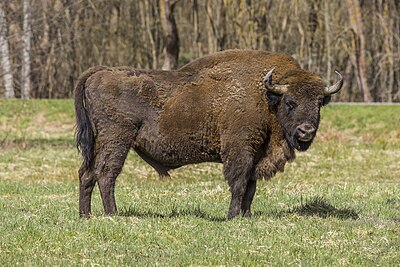
|
The European bison (Bison bonasus), also known as the wisent, is a mammal in the family Bovidae. It is one of two extant species of bison. Having been hunted to extinction in the wild by the early 20th century, the European bison was reintroduced to the wild in various European countries by the 2010s, following captive breeding programmes. It is the heaviest wild land animal in Europe, and individuals in the past may have been even larger than their modern-day descendants. The largest bulls of the species have a mass of up to 1,000 kilograms (2,200 lb). The European bison is a herd animal, which lives in both mixed and solely male groups. Mixed groups consist of adult females, calves, young aged two to three years, and young adult bulls. A typical herd numbers around eight to thirteen animals on average. This male European bison was photographed in the Białowieża Forest, Poland. Photograph credit: Charles J. Sharp
Recently featured:
|
November 16

|
Artemis I was an uncrewed Moon-orbiting mission that was launched on November 16, 2022. It was the first major spaceflight of NASA's Artemis program and marked the agency's return to lunar exploration since the Apollo program after five decades. It was the first flight test of the Orion spacecraft and the Space Launch System (SLS) rocket, and the mission's main objective was to test the Orion spacecraft in preparation for future Artemis missions. Artemis I was launched from Launch Complex 39B at the Kennedy Space Center. After reaching orbit, the upper stage separated and performed a trans-lunar injection before releasing Orion and ten CubeSat satellites. Orion completed one flyby of the Moon on November 21 and completed a second flyby on December 5. This picture shows Artemis I launching from Launch Complex 39B. Photograph credit: NASA/Joel Kowsky
Recently featured:
|
November 15

|
|
Sherman's March to the Sea was a military campaign of the American Civil War conducted through Georgia by Major General William Tecumseh Sherman of the Union army. The campaign began on November 15, 1864, with Sherman's troops leaving Atlanta, recently taken by Union forces, and ended with the capture of the port of Savannah on December 21. His forces followed a "scorched earth" policy, destroying military targets as well as industry, infrastructure, and civilian property, disrupting the Confederacy's economy and transportation networks. The operation debilitated the Confederacy and helped lead to its eventual surrender. This picture shows an engraving by Alexander Hay Ritchie depicting Sherman's March to the Sea. Engraving. credit: Alexander Hay Ritchie; restored by Adam Cuerden
Recently featured:
|
November 14

|
Percy Grainger (1882–1961) was an Australian-born composer, arranger and pianist who played a prominent role in the revival of interest in British folk music in the early 20th century. Grainger left Australia in 1895 to study at the Hoch Conservatory in Frankfurt. Between 1901 and 1914 he was based in London, where he established himself first as a society pianist and later as a concert performer, composer and collector of original folk melodies. He met many of the significant figures in European music, forming friendships with Frederick Delius and Edvard Grieg, and became a champion of Nordic music and culture. In 1914, Grainger moved to the United States, where he took citizenship in 1918. He experimented with music machines that he hoped would supersede human interpretation. Although much of his work was experimental and unusual, the piece with which he is most generally associated is his piano arrangement of the folk-dance tune "Country Gardens". This glass negative of Grainger was taken at some point around 1915–1920. Photograph credit: Bain News Service; restored by Adam Cuerden and MyCatIsAChonk
Recently featured:
|
November 13

|
The Réunion stonechat (Saxicola tectes) is a species of stonechat in the family Muscicapidae, the Old World flycatchers. It is found across the French Indian Ocean island of Réunion in forests, shrublands, and artificial environments such as gardens and plantations. The Réunion stonechat is a member of the common stonechat superspecies, but it is distinct, together with its closest relative the Madagascar stonechat, from the rest of that group being insular derivatives of the African stonechat. The male is black above and white below, with a white supercilium (sometimes absent), half-collar, covert patch, and a variable-sized orange patch on the breast. Females differ from males in being browner above, more buff-toned below, and often lacking the white greater covert patch. This male Réunion stonechat was photographed in La Roche Écrite, south of the Réunion capital Saint-Denis. Photograph credit: Charles J. Sharp
Recently featured:
|
November 12
|
Contemporary climate change involves rising global temperatures and significant shifts in Earth's weather patterns. Climate change is driven by emissions of heat-trapping greenhouse gases such as carbon dioxide and methane. Emissions come mostly from burning fossil fuels (coal, oil and natural gas), and also from agriculture, forest loss, cement production and steel making. Climate change causes sea level rise, glacial retreat and desertification, and intensifies heat waves, wildfires and tropical cyclones. These effects of climate change endanger food security, freshwater access and global health. Climate change can be limited by using low-carbon energy sources such as wind and solar energy, by forestation, and shifts in agriculture. Adaptations such as coastline protection cannot by themselves avert the risk of severe, pervasive and irreversible impacts. Limiting global warming in line with the goals of the 2015 Paris Agreement requires reaching net-zero emissions by 2050. This animation, produced by NASA's Scientific Visualization Studio with data from the Goddard Institute for Space Studies, shows global surface temperature anomalies from 1880 to 2023 on a world map, illustrating the rise in global temperatures. Normal temperatures (calculated over the 30-year baseline period 1951–1980) are shown in white, higher-than-normal temperatures in red, and lower-than-normal temperatures in blue. The data are averaged over a running 24-month window. Video credit: NASA; visualized by Mark SubbaRao
Recently featured:
|
November 11

|
Shirley Graham Du Bois (November 11, 1896 – March 27, 1977) was an American-Ghanaian writer, playwright, composer, and activist for African-American causes. Born in Indianapolis to an Episcopal minister, she moved with her family throughout the United States as a child. After marrying her first husband, she moved to Paris to study music at the Sorbonne. After her divorce and return to the United States, Graham Du Bois took positions at Howard University and Morgan College before completing her BA and master's at Oberlin College in Ohio. Her first major work was the opera Tom-Tom, which premiered in Cleveland in 1932. She married W. E. B. Du Bois in 1951, and the couple later lived in Ghana, Tanzania and China. She won several prizes, including an Anisfield-Wolf Book Award for her 1949 biography of Benjamin Banneker. This photograph of Graham Du Bois was taken by Carl Van Vechten in 1946. Photograph credit: Carl Van Vechten; restored by Adam Cuerden
Recently featured:
|
November 10
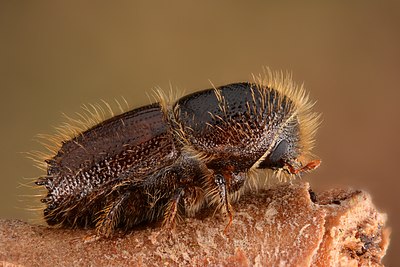
|
The European spruce bark beetle (Ips typographus), is a species of bark beetle in the true weevil family, Curculionidae. It is found in Europe and Asia Minor and east to China, Japan, North Korea and South Korea. Bark beetles are so named because they reproduce in the inner bark, living and dead phloem tissues, of trees. Their preferred trees in which to reside include spruces, firs, pines and larches. The species has the ability to spread quickly over large areas and some scientists hypothesize that long-distance movements originating from the Iberian Peninsula may have contributed to its invasion of northern Norway spruce forests. This female European spruce bark beetle was photographed in Naninne in the province of Namur, Belgium. Photograph credit: Ivar Leidus
Recently featured:
|
November 9

|
Pyromorphite is a mineral species composed of lead chlorophosphate: Pb5(PO4)3Cl, sometimes occurring in sufficient abundance to be mined as an ore of lead. First distinguished chemically by Martin Heinrich Klaproth in 1784, it was named pyromorphite by Johann Friedrich Ludwig Hausmann in 1813. It is usually green, yellow or brown in color, with a resinous lustre. Crystals are common and have the form of a hexagonal prism terminated by the basal planes, sometimes combined with narrow faces of a hexagonal pyramid. Other forms include crystals with a barrel-like curvature and globular or reniform masses. Pyromorphite is part of the apatite group of minerals and bears a close resemblance physically and chemically with two other minerals, mimetite and vanadinite. This focus-stacked photograph, merged from 26 separate images, shows a sample of pyromorphite extracted from the Resuperferolitica Mine in Santa Eufemia, in the Spanish province of Córdoba. The sample measures 3.5 cm × 3.0 cm × 1.5 cm (1.38 in × 1.18 in × 0.59 in). Photograph credit: David Ifar
Recently featured:
|
November 8

|
John Tarleton (8 November 1811 – 25 September 1880) was a Royal Navy officer who went on to be Second Naval Lord. He was given command of the fifth-rate HMS Fox in 1852, of the frigate HMS Eurydice in 1855 and of the frigate HMS Euryalus in 1858: he led the latter ship as an element of the Channel Squadron and then of the Mediterranean Squadron. Tarleton served as Junior Naval Lord from 1871 and then as Second Naval Lord from 1872 to 1874. He was promoted to Vice Admiral in 1875 and retired in 1879. He is seen here in an 1860 photograph by John Jabez Edwin Mayall. Photograph credit: John Jabez Edwin Mayall; restored by User:Adam Cuerden
Recently featured:
|
November 7
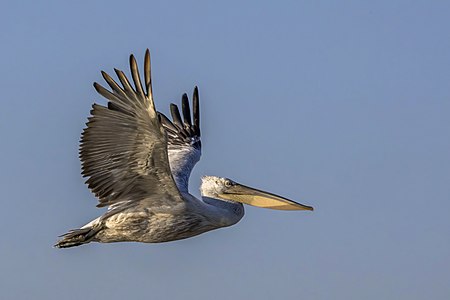
|
|
The Dalmatian pelican (Pelecanus crispus) is a bird in the family Pelecanidae. With a length of 160 to 183 centimetres (63 to 72 inches), a mass of 7.25 to 15 kilograms (16.0 to 33.1 pounds) and a wingspan of 245 to 351 centimetres (96 to 138 inches), it is the largest pelican species and one of the world's largest living flying birds. The Dalmatian pelican has a range spanning across much of central Eurasia, from the Mediterranean in the west to the Taiwan Strait in the east, and from the Persian Gulf in the south to Siberia in the north. It is a short-to-medium-distance migrant between breeding and overwintering areas. The Dalmatian pelican's preferred habitat is lakes, rivers, deltas and estuaries, and it feeds on various fish species such as the common carp and European perch. Like many pelicans, it is often silent, but can be vocal during the mating season, engaging in a wide range of guttural, deep vocalisations, including barks, hisses and grunts. This Dalmatian pelican was photographed in flight over the Danube Delta in Romania. Photograph credit: Charles J. Sharp
Recently featured:
|
November 6

|
|
Cecilia Payne-Gaposchkin (1900–1979) was a British-born American astronomer and astrophysicist who proposed in her 1925 doctoral thesis that stars were composed primarily of hydrogen and helium. Her groundbreaking conclusion was initially rejected because it contradicted the scientific wisdom of the time, which held that there were no significant elemental differences between the Sun and Earth. Independent observations eventually proved she was correct. Her work on the nature of variable stars was foundational to modern astrophysics. Photograph credit: Science Service; restored by Adam Cuerden
Recently featured:
|
November 5

|
|
The tentacled flathead (Papilloculiceps longiceps) is a species of marine fish belonging to the flathead family, Platycephalidae. It is found in the western Indian Ocean, including the Red Sea, and also in the Mediterranean Sea, probably as a result of migration through the Suez Canal. The tentacled flathead is a well camouflaged, ambush predator of fish and crustaceans, living near coral reefs on sand or rubble substrates at depths of up to 15 metres (49 feet). The species has an elongate body, with a maximum published length of 70 centimetres (28 inches), although 50 centimetres (20 inches) is more typical. It has a depressed head with five prominent nuchal spines, ridges on its operculum and preoperculum, a spine on the rear of the suborbital ridge, and smaller spines elsewhere. The body is mottled brownish or greenish dorsally, and whitish ventrally. There are three or four dark bands on the caudal fin, and the other fins are marked with large, dark blotches. This tentacled flathead was photographed in the Red Sea in Ras Muhammad National Park, off the southern coast of the Sinai Peninsula in Egypt. Photograph credit: Diego Delso
Recently featured:
|
November 4

|
The Abduction of Europa is a 1632 oil-on-panel painting by Rembrandt. One of his rare mythological works, it was inspired by Ovid's Metamorphoses, part of which tells the tale of Zeus's seduction and capture of Europa. The painting shows a coastal scene with Europa being carried away in rough waters by Zeus in the form of a bull while her friends remain on shore with expressions of horror. The use of an ancient myth to impart a contemporary thought and his portrayal of the scene using the High Baroque style are two strong aspects of the work. It was also influenced by Titian's painting of the same subject 70 years earlier, although there are significant differences; Rembrandt's painting is less violent in nature than Titian's. The Abduction of Europa is now in the collection of the J. Paul Getty Museum in New York City. Painting credit: Rembrandt
Recently featured:
|
November 3

|
|
The coconut (Cocos nucifera) is a member of the palm tree family, Arecaceae. Originally native to the Central Indo-Pacific, in the regions of Maritime Southeast Asia and Melanesia, coconuts are now found across the world due to human cultivation and dispersal. They are normally cultivated in hot and wet tropical climates. The term coconut also commonly refers to the seed and fruit of the coconut tree, which is botanically a drupe. The fruit has three layers including an edible white, fleshy endosperm and is filled with a liquid known as coconut water. The coconut thus played a critical role in the migration of Austronesian peoples across the Indian Ocean, as it provided a portable source of both food and water for long sea voyages. In modern times coconuts are used extensively in cooking and cuisine, using the raw flesh, the water or in alternative forms such as coconut milk and coconut butter. These coconuts, one whole and one halved, were grown in the Dominican Republic; this photograph was focus-stacked from 19 separate images. Photograph credit: Ivar Leidus
Recently featured:
|
November 2
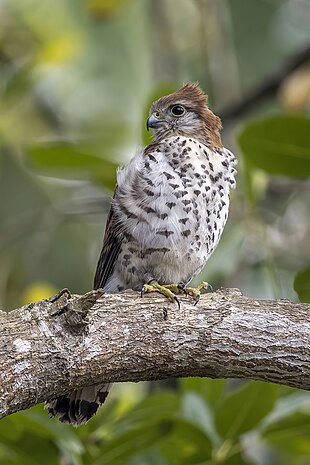
|
The Mauritius kestrel (Falco punctatus) is a bird of prey from the family Falconidae endemic to the forests of Mauritius, where it is restricted to the southwestern plateau's forests, cliffs, and ravines. It colonized the island and evolved into a distinct species from other Indian Ocean kestrels, probably during the Gelasian or Early Pleistocene periods. The Mauritius kestrel can reach a size between 26 and 30.5 cm (10.2 and 12.0 in), with a mass of up to 250 g (8.8 oz) and rounded wings with a span of approximately 45 cm (18 in). Males are slightly smaller than the females. It is a carnivorous bird, eating geckos, dragonflies, cicadas, cockroaches, crickets, and small birds. It hunts by means of short, swift flights through the forests. This Mauritius kestrel was photographed in the Ebony Forest reserve near Chamarel, Mauritius. Photograph credit: Charles J. Sharp
Recently featured:
|
November 1

|
|
Diwali is a five-day Hindu festival of lights which symbolises the spiritual victory of light over darkness and good over evil. It commemorates the day when Hindu god Rama, along with his wife-consort Sita and brother Lakshmana, returned to his kingdom of Ayodhya after defeating demon-king Ravana and following 14 years of exile. Celebrations peak on the night of the third day of the festival—the main day of Diwali, which is today—marking the darkest night of the Hindu lunisolar calendar. People celebrate on this day by lighting traditional lamps (diyas) and candles. Pictured here is a woman lighting candles on Diwali. Photograph credit: AjoyDutta1997; edited by Aristeas
Recently featured:
|
October 31
|
The Cabinet of Dr. Caligari is a German silent horror film, first released in 1920. Directed by Robert Wiene and written by Hans Janowitz and Carl Mayer, it is considered to be the quintessential work of German Expressionist cinema, and tells the story of an insane hypnotist (Werner Krauss) who uses a somnambulist (Conrad Veidt) to commit murders. The film features a dark and twisted visual style. The sets have sharp-pointed forms, oblique and curving lines, and structures that lean and twist in unusual angles. The film's design team, Hermann Warm, Walter Reimann and Walter Röhrig, recommended a fantastic, graphic style over a naturalistic one. With a violent and insane authority figure as its antagonist, the film expresses the theme of brutal and irrational authority. Considered a classic, it helped draw worldwide attention to the artistic merit of German cinema and had a major influence on American films, particularly in the genres of horror and film noir. Film credit: Robert Wiene
Recently featured:
|
October 30

|
Anna Bartels (1869–1950) was a Swedish operatic soprano and mezzo-soprano. She made her debut at the Royal Swedish Opera in 1897 in the title role of Friedrich von Flotow's Martha. Engaged by the company for the next 20 years, she appeared in many Swedish premieres, such as Musette in Puccini's La bohème (1901), Marianne in Richard Strauss's Der Rosenkavalier (1920) and La Ciesca in Puccini's Gianni Schicchi (1920). Other works in which she appeared include The Merry Wives of Windsor, The Magic Flute, Don Giovanni and Carmen. Bartels is also remembered for her appearances in concerts and lieder recitals. She was awarded the Litteris et Artibus medal in 1923 for her contributions to Swedish culture. This 1901 photograph by the Swedish photographer Ferdinand Flodin shows Bartels in her role as Musette. Photograph credit: Ferdinand Flodin; restored by Adam Cuerden
Recently featured:
|
October 29
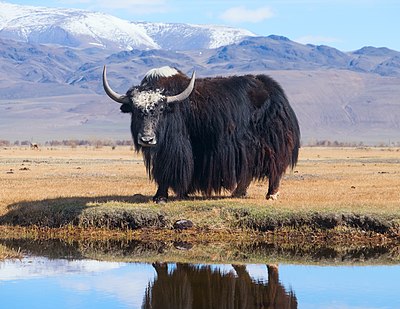
|
The yak (Bos grunniens) is a species of long-haired domesticated cattle in the family Bovidae. It is found throughout the Himalayas in Pakistan, India, the Tibetan Plateau of China, Tajikistan, and as far north as Mongolia and Siberia, Russia. Yak physiology is well adapted to high altitudes and cold weather, featuring larger lungs and heart than other cattle, a greater capacity for transporting oxygen through their blood and a thick layer of subcutaneous fat. Yaks have been domesticated in areas such as Mongolia and Tibet, primarily for their fibre, milk and meat, and as beasts of burden. Yaks' milk is often processed to a cheese called chhurpi in the Tibetan and Nepali languages, and byaslag in Mongolia, while butter made from yaks' milk is an ingredient of Tibetan butter tea. This yak was photographed near the river Chuya in the Altai Republic, a region in southern Siberia. Photograph credit: Alexandr Frolov
Recently featured:
|
October 28

|
Le roi d'Ys is an opera in three acts by the French composer Édouard Lalo, to a libretto by Édouard Blau. It is based on the old Breton legend of the drowned city of Ys, which was according to the legend the capital of the kingdom of Cornouaille. The opera includes a noteworthy aubade for tenor in act 3, titled "Vainement, ma bien-aimée" (In vain, my beloved). Le roi d'Ys premiered on 7 May 1888 at the Théâtre Lyrique in Paris, in a production by the Opéra-Comique. Within France, the opera was regarded as Lalo's most recognized work. This poster was produced by Auguste François-Marie Gorguet for the 1888 premiere of Le roi d'Ys, and depicts the final scene of the opera. Poster credit: Auguste François-Marie Gorguet; restored by Adam Cuerden
Recently featured:
|
October 27

|
Acer negundo, also known as the box elder, is a species of maple in the family Sapindaceae, native to North America. It is a fast-growing, short-lived tree with opposite, ash-like compound leaves. It is sometimes considered a weedy or invasive species, and has been naturalized throughout much of the world. It grows up to 10 to 25 metres (35 to 80 feet) tall, with a trunk diameter of 30 to 50 centimetres (12 to 20 inches). Male and female flowers appear on separate plants, with flowers on male plants generally appearing in clusters of four and flowers on female plants appearing as a raceme. These flowers of a female A. negundo plant were photographed in Keila, Estonia. Photograph credit: Ivar Leidus
Recently featured:
|
October 26

|
The greater white-fronted goose (Anser albifrons) is a species of goose in the family Anatidae. It is closely related to the lesser white-fronted goose, which is smaller. The greater white-fronted goose is migratory, breeding in northern Canada, Alaska, Greenland and Russia, and winters farther south in North America, Europe and Asia. The greater white-fronted goose has a length of 64 to 81 cm (25 to 32 in), a wingspan of 130 to 165 cm (51 to 65 in), and a mass of 1.93 to 3.31 kg (4 lb 4 oz to 7 lb 5 oz). Males are typically larger in size, and both sexes are similar in appearance – greyish brown with light grey breasts dappled with dark brown to black blotches and bars. Both males and females also have a pinkish bill, and orange legs and feet. This greater white-fronted goose was photographed in flight in the Central Valley of the US state of California. Photograph credit: Frank Schulenburg
Recently featured:
|
October 25
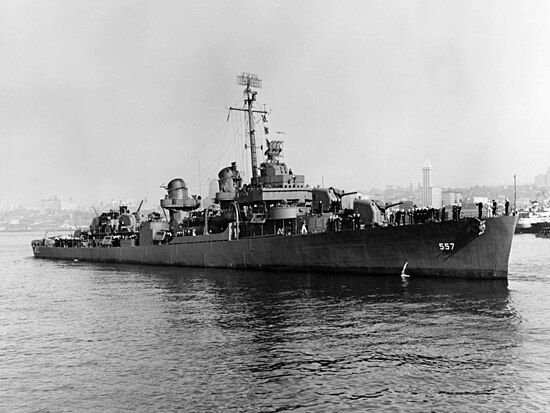
|
|
USS Johnston was a Fletcher-class destroyer built for the United States Navy during World War II. She was named after Lieutenant John V. Johnston, a navy officer during the American Civil War. The ship was laid down in May 1942 and was launched in March 1943, entering active duty later that year as part of the US Pacific Fleet. Johnston provided naval gunfire support for American ground forces during the Gilbert and Marshall Islands campaign in 1944 and again, after three months of patrol and escort duty in the Solomon Islands, during the recapture of Guam in July. Thereafter, Johnston was tasked with escorting escort carriers during the Mariana and Palau Islands campaign and the liberation of the Philippines. On 25 October 1944, Johnston and various other ships were engaged by a large Imperial Japanese Navy flotilla, in what became known as the Battle off Samar. After engaging several Japanese capital ships and a destroyer squadron, Johnston was sunk with 187 dead. Johnston's wreck was discovered in 2019, and at a depth of more than 20,000 feet (6,100 m) below the surface, is one of the deepest shipwrecks ever surveyed. This photograph shows Johnston in Seattle in October 1943. Photograph credit: unidentified US Navy photographer; restored by Adam Cuerden and Cobatfor
Recently featured:
|
October 24

|
|
The mortuary temple of Hatshepsut is a mortuary temple built during the reign of Hatshepsut, a pharaoh of the Eighteenth Dynasty of Egypt, around the 15th century BC. Located opposite the city of Luxor, the temple's three terraces rise above the desert floor and into the cliffs of Deir el-Bahari. Hatshepsut's tomb lies inside the same massif, capped by El Qurn, a pyramid for her mortuary complex. At the edge of the desert, one kilometre (0.6 miles) east, connected to the complex by a causeway lies the accompanying valley temple. Across the river Nile, the whole structure points towards the monumental Eighth Pylon, Hatshepsut's most recognizable addition to the temple of Karnak. The temple's twin functions are identified by its axes: its main east–west axis served to receive the barque of Amun-Re at the climax of the festival, while its north–south axis represented the life cycle of the pharaoh from coronation to rebirth. This aerial photograph shows the reconstructed mortuary temple of Hatshepsut, viewed from the southeast. Photograph credit: Diego Delso
Recently featured:
|
October 23

|
The hairy dragonfly (Brachytron pratense) is a species of European dragonfly in the hawker family, Aeshnidae. It is found in Europe and Asia Minor, as far east as the Caspian Sea, and resides close to water bodies containing plants with a flight season running from May to July. The hairy dragonfly is named for its hairy thorax, distinguishing it from other hawkers. With a typical length of around 5.5 centimetres (2.2 in), it has a long, narrow pterostigma and features coupled, oval-shaped markings on its abdomen, blue on males and yellow on females. This male hairy dragonfly on a fern was photographed in Burren National Park, County Clare, Ireland. Photograph credit: Charles J. Sharp
Recently featured:
|
October 22

|
Archibald Sinclair, 1st Viscount Thurso (22 October 1890 – 15 June 1970) was a Scottish politician and leader of the Liberal Party. After an education at the Royal Military College, Sandhurst, Sinclair served on the Western Front during the First World War, rising to the rank of Major and working under J. E. B. Seely and Winston Churchill. After the war he worked with Churchill again when the latter was Secretary of State for War and Secretary of State for the Colonies. Sinclair entered the House of Commons as a Liberal MP in 1922, rising to become the party's Chief Whip by 1930. When the Liberal Party joined the National Government of Ramsay MacDonald in 1931, Sinclair was appointed Secretary of State for Scotland, holding the post until his party resigned from the government in 1932. He took over as Liberal Party leader in 1935 after incumbent Herbert Samuel lost his seat in the election. Sinclair returned to government as Secretary of State for Air in 1940, under Churchill's all-party Second World War coalition government. In this role he worked with the Royal Air Force (RAF) to plan the Battle of Britain. Sinclair remained a minister until the end of the coalition in 1945, but then lost his seat in the 1945 general election. He was elevated to the House of Lords in 1952. This portrait of Sinclair was taken by the RAF official photographer during the Second World War. Photograph credit: Royal Air Force official photographer
Recently featured:
|
Picture of the day archives and future dates
